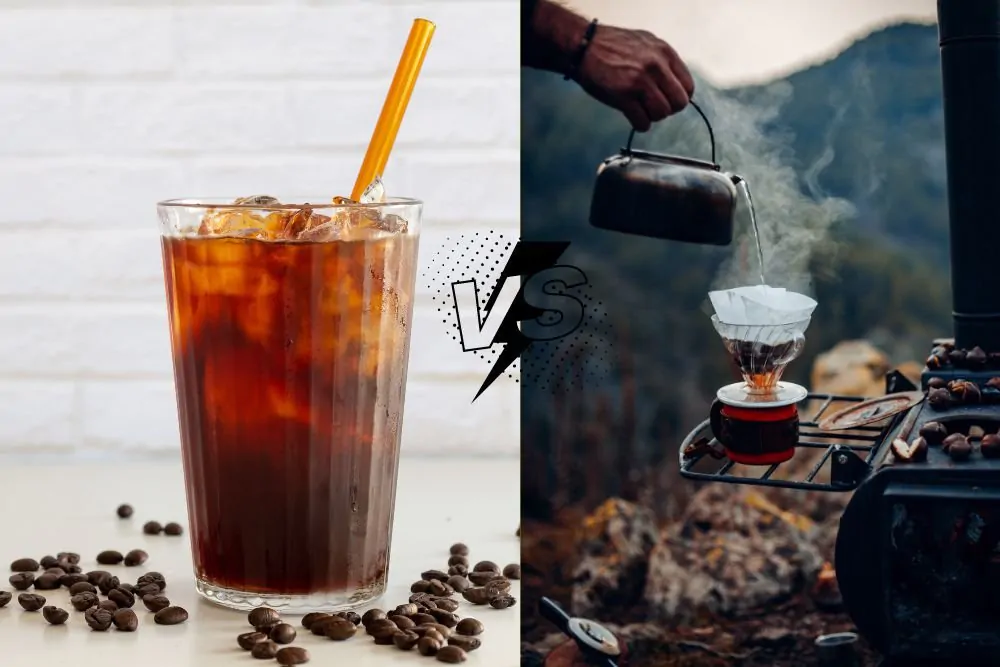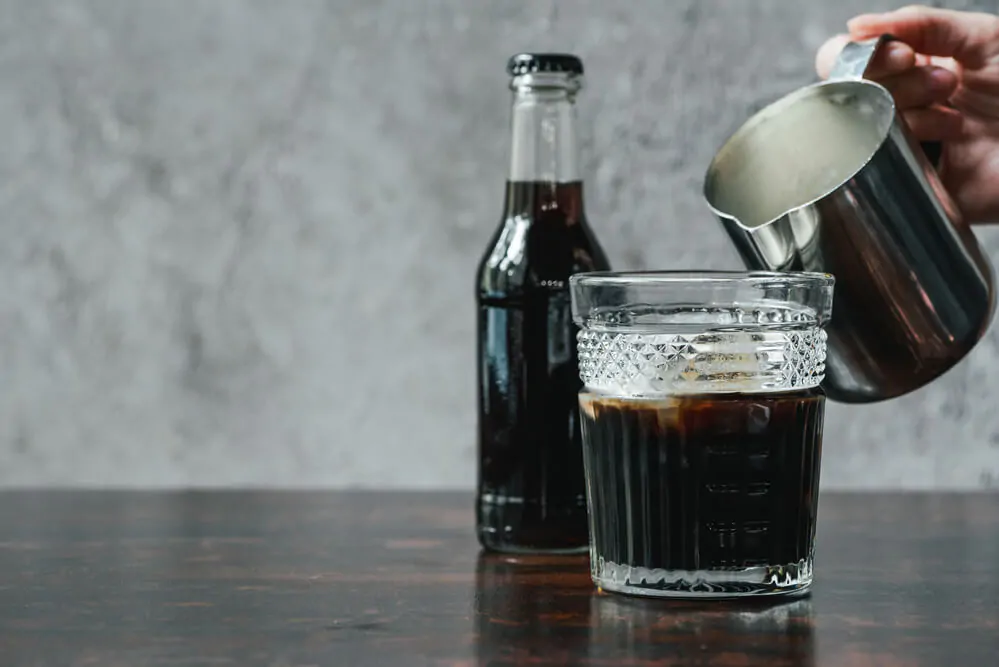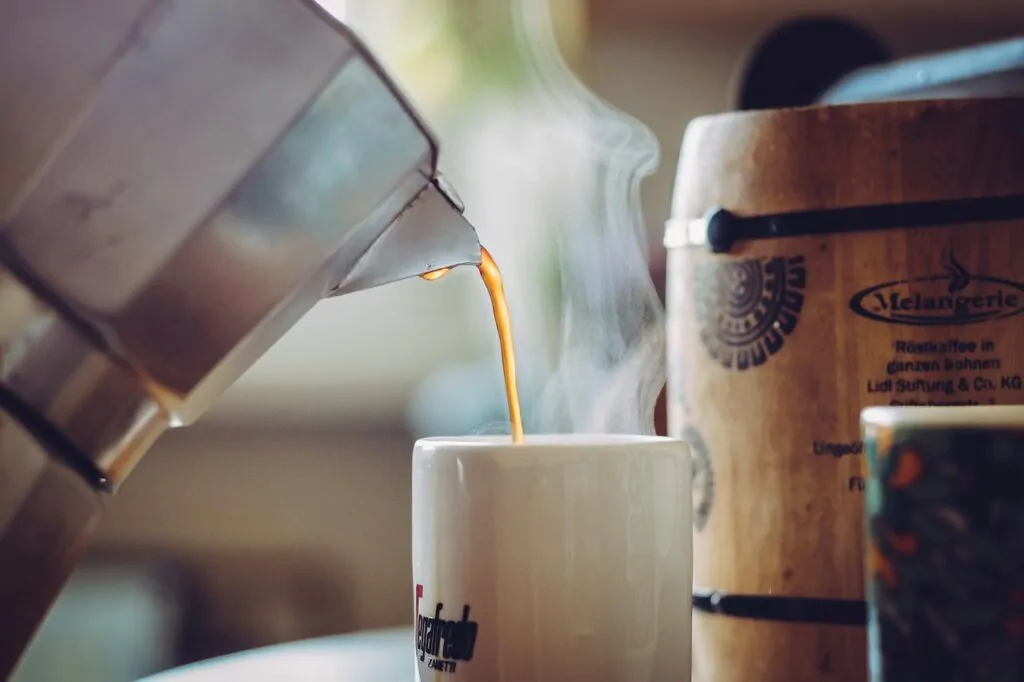In the world of coffee, not all methods are made equal, and cold brew vs. hot brew coffee offers a different way to make and enjoy your favorite drink.

When I learned brewing coffee isn’t a matter of dripping hot water over some coffee ground, I was astonished. The two main methods of brewing, namely cold brew and hot brew, made me look at (and taste) a good cup of coffee differently.
I know my preference, but when considering cold brew vs. hot brew, what would you pick? To save you time, I’ve researched both and also tried my hand at cold coffee brewing. Here are my findings.
Cold Brew vs. Hot Brew: An Overview
There’s not much that you can tell a coffee lover like me about hot brews. We enjoy discussing the merits of drip coffee and simply adore shots of rich espresso. Come any morning — and often afternoons too — of the week, you’ll find us with a cappuccino or latte in hand, gaining comfort and renewed strength from our daily caffeine fix.
Hot brewing describes when you add heated water to a coffee ground to create an extract. Since this process is substantially faster, I need less coffee grind, which means the ratio of coffee to water increases. I use a ratio of 1 part coffee to 17 parts water.
Cold brew is, as the name says, brewing that involves pouring water (at room temperature) over the coffee ground. Since the water is cold, it requires a longer brewing period, with the brew taking anything from 12-24 hours.
The ground is also a coarser grind than other coffee grounds, and this releases the flavor more slowly. However, the taste is full-bodied, and it’s ideal for large volumes of coffee as you can store it in the fridge for quite some time without ruining the flavor. This method of brewing is ideal for rich coffees that have a hint of coco and nut.
The result is a very different coffee brew than what you get by icing coffee or brewing it with hot water.
You’ll love our round-up of the best cold brew coffee brands.
What’s the Difference in Taste?

Coffee is made up of a lot of different compounds, such as sugars, oils, and aromatic compounds, which naturally oxidize, or break down.
When you add hot water to coffee grounds, it speeds up the rate at which the compounds are broken down. This gives hot coffee brews a good balance between the acid and sugars present in the coffee.
To make a cold brew, you use twice the amount of coffee and leave the coffee steep at cold temperatures. The higher coffee-to-water ratio and longer brewing period are necessary for the solubles to be extracted from the coffee grounds.
The cooler temperature slows down the process of oxidation, which results in a different flavor. You’ll immediately notice the sweeter aroma and flavor of cold brews. These brews have much less acidity, little to no bitterness, and a smooth texture.
Cold Brew vs. Hot Brew: A Comparison
| Hot Brew | Cold Brew |
| Uses water at a temperature of 195-205℉ | Brewed using room temperature water |
| Brews within a matter of minutes | Sweeter coffee due to the cold temperature of the water that doesn’t extract as much bitter compounds from coffee grind as hot brewed coffee |
| Consumed immediately | Can be stored for several hours or even days, depending on the sensory degradation, or loss of taste |
| Predominantly bitter coffee due to the faster extraction rate of bitter compounds and acids in coffee grind | Sweeter coffee due to the cold temperature of the water that doesn’t extract as many bitter compounds from coffee grind as hot brewed coffee |
What’s Better About Cold Brew Coffee?
If you like coffee with a caffeine kick, cold brews do the trick. Although cold brews are typically diluted with water or creamer, some of the ready-to-drink beverages on the market contain more caffeine than you’ll get from a regular drip-brew. Cold brews are also popular with the younger generations since they are a bit of a novelty.
Millennials and Gen Zs enjoy experimenting with their coffee and are willing to pay a bit more to experience specialty coffee, such as a nitro cold brew. Grabbing a bottle of cold brew from a fridge is also a convenient and quick way to enjoy a tasty coffee drink.
Cold-brewed coffee usually contains fewer compounds that make a coffee taster bitter. As a coffee fanatic, I like the flavor and great kick a slow-brewed coffee gives.
In addition, I can store my cold-brewed coffee for a longer period of time, which is great since it takes a while to brew i.e. a large batch justifies the effort.
What’s Better About Hot Brewed Coffee?

Nothing beats a hot cuppa on a cold day. I prefer my hot brewed coffee in the morning and when the weather is cold. Hot brewing is faster, and I can easily use my coffee maker to make a delicious and steamy cuppa coffee in the morning by pushing a button.
Studies have found hot brews extract more antioxidants from the grind than cold brews, and increasingly more so the darker the roast. Hot-brewed coffee is less picky about the kind of coffee grind, so that is a huge plus point.
Who Should Get Cold Brews (And Why)?
If you’re a millennial or Gen Z who views coffee as an experience, experimenting with different cold coffee brews is an affordable luxury. Ready-to-grab cold brews also appeal to those who have busy lifestyles and are constantly on the run.
I found cold-brewed coffee to have a much sweeter taste, which works well as a dessert coffee or as a pick-me-up on a warm day. It complements a slice of cake or other desserts, and it’s ideal as a cuppa after a good meal.
In short, drink a cold brew if it’s a hot day, after dinner, or if you want to brew coffee in advance.
Who Should Get Hot Brews (And Why)?
Older generations are more likely to want to stick to what they know: hot brews. Coffee lovers who enjoy the complex and bold aromas and flavor profiles of hot brews are also likely to opt for hot brews.
There’s something comforting in a hot cup of coffee, and the aroma and flavor of hot brews have a depth and complexity that are missing from the sweeter cold brews.
Hot-brewed coffee remains my favorite. However, I can’t store hot coffee for long periods of time—yip, there’s only so long that it tastes great from the travel mug.
In short, drink a hot brew for your morning pick-me-up or immediately after brewing.
